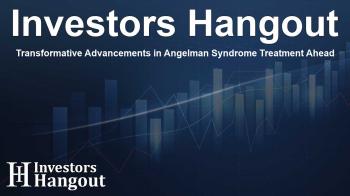Transformative Advancements in Angelman Syndrome Treatment Ahead

Significant Growth Expected in Angelman Syndrome Treatment Market
Recent estimates indicate a positive trajectory for the Angelman syndrome market over the next decade. This projected growth, extending from 2025 to 2034, is largely fueled by factors such as an increasing prevalence of this rare disorder, heightened awareness leading to better diagnosis, and the introduction of innovative therapeutic products.
Understanding Angelman Syndrome
Angelman syndrome is a complex neurogenetic disorder that affects about 1 in 15,000 live births, ultimately impacting roughly 500,000 individuals across the globe. This condition stems from the malfunction of the UBE3A gene, particularly the maternal copy located on chromosome 15. Genetic deletions and mutations cause a deficiency in functional UBE3A protein in the brain.
Identifying the Condition
Typically, symptoms of Angelman syndrome appear in early infancy, between 6 and 12 months, manifesting as global developmental delays. The prevalence is notably similar across genders, resulting in an estimated occurrence of 1 in 12,000 to 20,000 people within the general population.
Current Epidemiological Landscape
The landscape of Angelman syndrome in the United States showcases a diversity enhanced by evolving diagnostic capabilities and the increasing availability of genetic testing. As public consciousness grows, healthcare professionals become more adept at recognizing the signs, subsequently improving the identification rate of this syndrome, which can present developmental disabilities, significant speech challenges, and distinctive behavioral patterns.
Advancements in Treatment Approaches
Although there is no existing cure for Angelman syndrome, treatments currently available focus on a comprehensive strategy that incorporates symptom management and enhancement of quality of life. Medications such as antiepileptic drugs aim to control seizures, while behavioral therapies address emotional and social needs. Additionally, augmentative communication strategies and physical therapies are integral in fostering development and improving functional skills.
Emerging Therapies on the Horizon
The research community remains optimistic as advancements in experimental therapies hint at new solutions that could address the root genetic cause of Angelman syndrome, such as gene therapy and UBE3A reactivation strategies. Exciting clinical trials are paving the way for potential breakthroughs.
Details on New Medication Initiatives
Various emerging treatments are currently being evaluated in clinical trials, showcasing promising avenues for addressing Angelman syndrome. For instance, Ionis Pharmaceuticals' ION582 aims to enhance UBE3A protein production, with recent trial results indicating notable improvements in communication and cognitive functions. Plans for a Phase III trial are underway, indicating steady progress toward bringing this therapy to market.
Highlights of Innovative Drug Approaches
Similarly, Ultragenyx Pharmaceuticals is advancing GTX-102, targeting UBE3A-AS and aiming to restore the expression of the paternal UBE3A allele in neural cells. Regulatory approvals and positive interim results suggest that GTX-102 is poised to enter Phase III trials shortly.
Future Directions and Market Impact
The anticipated launch of these innovative therapies from leading pharmaceutical firms have the potential to significantly reshape the Angelman syndrome landscape, not only improving patient care but also creating new commercial opportunities within the healthcare market. DelveInsight expects to see substantial growth in the overall market size as these new solutions come to fruition, projected to expand at a remarkable CAGR through 2034.
Conclusion
The establishment of these new treatment protocols and the dedication of the pharmaceutical community to advancing therapies signal a pivotal shift in addressing the needs of individuals living with Angelman syndrome. Continued research and investment in this area are vital for creating effective treatments, improving healthcare outcomes, and enhancing the quality of life for affected individuals and their families.
Frequently Asked Questions
What is Angelman syndrome?
Angelman syndrome is a rare neurogenetic disorder characterized by developmental delays, intellectual disability, and unique behavioral features resulting from the loss of the UBE3A gene function.
How prevalent is Angelman syndrome?
Approximately 1 in 15,000 individuals are affected by Angelman syndrome, with estimates suggesting about 500,000 cases worldwide.
Are there any current treatments for Angelman syndrome?
While there is no cure, treatment strategies focus on symptom management through a multidisciplinary approach, including medication for seizures and behavioral therapies.
What new therapies are being developed for Angelman syndrome?
Innovative treatment options are being researched, including gene therapy and targeted drug therapies like ION582 and GTX-102.
What challenges do individuals with Angelman syndrome face?
Patients often encounter difficulties in communication, developmental delays, and may require long-term support services as they transition into adulthood.
About The Author
Contact Lucas Young privately here. Or send an email with ATTN: Lucas Young as the subject to contact@investorshangout.com.
About Investors Hangout
Investors Hangout is a leading online stock forum for financial discussion and learning, offering a wide range of free tools and resources. It draws in traders of all levels, who exchange market knowledge, investigate trading tactics, and keep an eye on industry developments in real time. Featuring financial articles, stock message boards, quotes, charts, company profiles, and live news updates. Through cooperative learning and a wealth of informational resources, it helps users from novices creating their first portfolios to experts honing their techniques. Join Investors Hangout today: https://investorshangout.com/
The content of this article is based on factual, publicly available information and does not represent legal, financial, or investment advice. Investors Hangout does not offer financial advice, and the author is not a licensed financial advisor. Consult a qualified advisor before making any financial or investment decisions based on this article. This article should not be considered advice to purchase, sell, or hold any securities or other investments. If any of the material provided here is inaccurate, please contact us for corrections.

